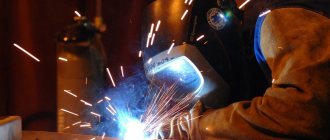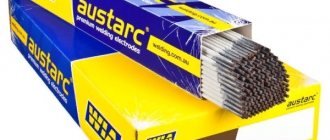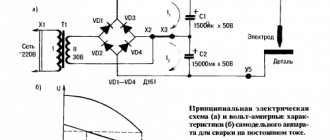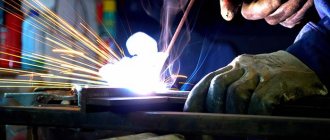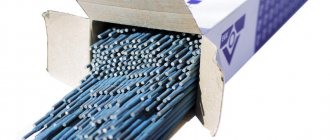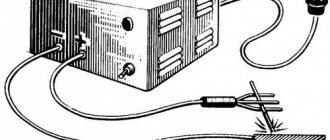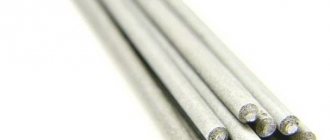There are a great variety of welding machines. They vary in functions, dimensions and many other criteria. But one of the most important technical indicators is the type of welding current obtained at the output during the welding process. There are only two such types: constant and variable.
Correct AC welding electrodes are the key to quality welder work. They have their own characteristics and precise technical characteristics.
What is alternating current in welding
Is it good or bad, which current is better? Variable or constant? No one will give you a definite answer.
Welding classification.
To begin with, it is better to understand the features of processes with alternating current, they are as follows:
- The behavior of the arc leaves much to be desired: with alternating voltage it is the most unstable.
- The welding seam is not of the highest quality due to deviation from the axis of the welding arc.
- If the arc goes out, its combustion can only be resumed when the voltage increases.
- The metal is splattered to a large extent.
Despite all these complexities, the equipment required for AC welding is simple and inexpensive. These are, first of all, transformers - devices that are still very popular among welding masters.
It would seem that electrodes for alternating current should gradually lose their relevance: after all, many rectifiers have appeared on the market - inexpensive and with small dimensions convenient for use. However, these consumables are still in demand in many industries and handicraft workshops.
Most of the brands are universal, which is also extremely suitable for older generation domestic welders.
If you look at it, the best consumables for “change” have and show very serious production advantages. First of all, this concerns the resulting electric arc: its durability and easy ignition. Another feature of such electrodes is the low level of metal spattering during welding.
Welding transformer
Electrode diameter and steel thickness.
To carry out welding using a transformer, the following mandatory structural elements are required:
- Windings primary and secondary. The primary is made of a special insulated wire; there is no insulation on the secondary winding.
- Magnetic wire.
- Screw for controlling the position of two windings and changing the distance between them.
- Protective housing for the entire unit.
- Screw handle, running nut.
- Fan and other elements depending on the transformer model.
Despite the fact that many welding professionals regard transformers as equipment of the “outgoing generation,” they are presented on the market in the form of a wide range of models of very different values and for wallets of any thickness.
Transformers differ according to the following criteria:
- dimensions and weight;
- output current strength;
- output voltage level at idle;
- volume of electricity consumed;
Welding generator
It is assessed as an independent device, necessary for operation if there is no full-fledged network electricity.
Electrode markings.
The generator design includes the required structural elements:
- The most important part - the converter consists of an electric generating element with an alternating voltage motor. They provide changes in current indicators.
- Drive internal combustion engine.
- Indicator for monitoring and recording current strength.
- Mode switches.
- Special circuit breaker.
- Regulators for current and arc behavior.
- Terminals for connecting cables and 230V outlets.
These types of generators are available in two versions:
- Collector generators.
- Valve generators.
The main advantages of a gas generator in comparison with other welding machines are:
- Compact and therefore highly mobile.
- Convenience, relative cheapness, noiselessness.
- Wide functionality and high reliability.
- Quite high technical characteristics.
Storage rules
Have you ever used a welding machine?
It happened! It didn’t happen
The main problem encountered during storage is high air humidity. The electrode coating quickly absorbs moisture, making it impossible to work with such filler material. The only way to correct the situation is to calcinate the welding electrodes.
For this, there are special ovens or portable canisters with heating elements. At home, it is recommended to store packages open (without polyethylene) at a temperature of 20-22 degrees, relative humidity 40-50%.
Wet electrodes can cause pores to appear on the surface and inside the seam, and an increase in metal spattering will also be observed.
To correctly select welding electrodes, you need to have a good understanding of what alloy you need to work with.
You should also carefully prepare the additive itself and the surfaces to be welded for the operation:
- Remove dirt and rust.
- Heat the electrodes.
- Set the welding current correctly.
If the technology is followed, you can count on obtaining seams with the characteristics specified by the electrode manufacturer.
AC electrodes
Electrodes for alternating current have an interesting feature: they are universal, that is, they are suitable for working with both alternating and direct voltage. Let us immediately note that electrodes for direct current do not in any way possess such versatility.
AC electrodes are used where transformers and generators are used as welding machines. Like the devices themselves, these electrodes are in great demand, since these methods can only be used during recess.
Both units and consumables are significantly cheaper than welding technologies based on the use of constant voltage. So the popularity and demand for “change” is not going to decrease.
Electrode markings for different types of coatings.
Advantages of AC electrodes:
- The use of alternating consumables does not require rectifiers in addition to the transformer.
- The weld pool is not exposed to the harmful effects of nitrogen and oxygen from the air.
- The versatility of this type of consumables.
Disadvantages of variable consumables:
- The main disadvantage is that the quality of the welds is lower than when using constant voltage.
- Spattering of metal during welding.
- Low viscosity is under attack.
Four types of electrode coating:
- An acidic coating with the marking letter A, containing a high proportion of oxygen. This is a typical “station wagon”; such consumables can also be used on direct current.
- “Basic” coating marked with the letter B. They have a high ionization potential, which is why it is better not to work with them on alternating current.
- Rutile coating usually consists of half a special rutile concentrate, and it is very loyal to alternating current.
- Cellulose electrodes are suitable for direct current operation.
Of all the possible coating options, the most popular for work with alternating current is rutile coating.
Briefly about coverage problems
The coating serves to protect the bath and, of course, to stabilize the arc. The coating also determines the degree of ionization and is responsible for the occurrence of physical and chemical processes in the weld pool. It follows from this that the required mechanical properties of the weld metal and the joint as a whole are largely ensured by electrode coating.
So, for welding especially critical structures operating at subzero temperatures and static loads, where increased strength and ductility are required, direct current is required, and therefore welding materials, in particular electrodes, must be selected taking into account these requirements.
AC Electrode Rating
Types of electrodes for welding with alternating and direct current.
The type of current is indicated in all markings of consumables - this is always the last digit. The main thing is to remember that if the last place in the marking is 0, then the electrode is not suitable for welding with alternating current.
- OZS – 12 with rutile coating. The most common type of electrodes for welding with alternating current, which is used on almost all Russian-made machines. Excellent welding of carbon steel parts, suitable for connections of critical structures. Significant advantages of these electrodes are the ability to work in any position in space, the absence of pores in the seam, a stable arc, and a completely acceptable dose of toxic gases released during the welding process.
- MP – 3 are designed for welding low-carbon steels. The advantages are similar: excellent arc stability, acceptable metal spatter. The slag crust comes off very easily. With these consumables you can cook even rusty, damp and poorly cleaned workpieces.
- ANO – 4 are also used for carbon steels. Excellent arc that ignites quickly and easily. You can cook wet and rusty products. There are no pores or cracks during seam formation. Easy separation of slag crust. There is virtually no metal spattering.
- MP-3C are distinguished by their high versatility: they are suitable for both low-alloy and carbon steels. The arc is ignited easily and instantly, the seam is protected from slag and oxides due to the rutile coating. The seams are smooth and durable, they can withstand significant loads. You can work with them in any position in space.
- ANO – 6 are used for connecting parts made of low-carbon steels. They are not afraid of rust, scale and dirt. The arc is stable and easily ignited, the seam is formed correctly.
- OZS – 4 for carbon steels, can be welded in any spatial position. The arc ignites easily. You can weld metal workpieces with edges of medium and large thickness at high temperatures. Attention! Doesn't like dirt on the surfaces being welded - they stop working.
- ANO – 21 are also intended for steels with carbon additives and low-alloy alloys. They are very easy to handle, can be worked in any position, and are also used in conjunction with an inverter and a semi-automatic transformer. The metal hardly splashes during operation, and the slag in the form of a crust is easily separated. An arc with excellent qualities - stable and soft.
- OZS – 6 are intended for carbon steels. They are characterized by a high throughput speed, which gives high labor productivity with a welding seam of excellent quality. Capable of welding oxidized surfaces.
Operating modes
So, how to choose the right mode to ensure high-quality and durable work? First, pay attention to the spatial position. When welding, the metal flows down one way or another, so in a vertical position it is better to set the minimum current to control the rate of metal melting. Using the same logic, select the current mode for other positions. Below you can see a table in which we have collected the main operating modes.
DC Electrode Rating
Differences in welding with different current polarities.
Types of electrodes used for DC welding:
- UONI - 13/55 - famous electrodes of their kind for direct current, applicable for steel alloys - with low doses of alloying elements and with the addition of carbon. They have significant advantages: the welding seam is very plastic and tough for mechanical stress, very durable. Almost no impurities and gases are formed. The arc is easily ignited. A wire of parameters Sv-08 or Sv-08A is placed in the rod.
- UONI - 13/45 are also used for joining workpieces made of carbon and low-alloy steels. The seam is not inclined to form cracks - neither hot nor cold. It is very ductile and tough, with ideal tightness, which makes it a suitable option for welding containers that will subsequently be subject to high pressure. Seams made with these electrodes do not age much longer.
- OZL – 6 are distinguished by their narrow focus: they are used in working with heat-resistant steels. Pores and cracks do not form in the seams, they are not subject to further corrosion and have the same heat resistance as the base metal. Suitable for metals with different structures.
- OZS-12 are intended for steel alloys with a low proportion of alloying additives and carbon. It is possible to work in any spatial position and is tolerant of surfaces with rust. The weld is formed with excellent characteristics: strength and durability. Stable arc. There are no releases of toxic substances during operation.
- TsL - 11 are also highly specialized electrodes, which are intended for steel alloys with additions of chromium and nickel, as well as corrosion-resistant steels. Welded seams are resistant to corrosion. The metal hardly spatters, the arc is stable, and the slag in the form of a crust is easily separated.
- ANO - 21, despite the fact that they are also intended for carbon and low-alloy steel alloys, like previous brands of electrodes, these consumables are extremely popular among craftsmen of various levels of professional training. Their features are a fine-scale structure of the weld metal, excellent arc ignition, softness, slight metal spattering, and so on.
- LB – 52U are distinguished by the high productivity of the welding process with their help. The arc is stable, the metal hardly spatters, work is possible in any position in space, and almost no cracks form in the seam.
- MR - 3 typical universal electrodes, which are rightfully present in both lists - for both alternating and direct current. Pores and hot cracks practically do not form in the weld, the arc is powerful and stable, there is little spattering of metal, and easy separation of slag in the form of a crust.
- OZCH – 2 are intended for welding cast iron. Despite their seemingly narrow functional focus, they have solid advantages in the form of versatility, ease of use, an excellent arc with excellent characteristics, ductility of the weld without cracks, and a well-separated crust with slag at the end of the process.
Classification by purpose
Electrodes are intended for welding:
- Steels: low-carbon, high-carbon, alloyed - including stainless and heat-resistant (austenitic).
- Cast iron - alloys with a high carbon content - 2.14% or more.
- Aluminum and alloys.
- Copper, brass and bronze.
Expert opinion
Dmitry Konstantinovich Levin
Electrodes are not always used for their intended purpose. Example: a steel (and stainless steel) additive is used to weld some cast iron alloys.
- For welding steels of different grades
- For working with cast iron alloys
- For aluminum welding
- For working with copper and its alloys
To ensure a high-quality connection, you need to try to ensure that the composition of the electrode material matches as closely as possible the alloy of the parts being welded.

